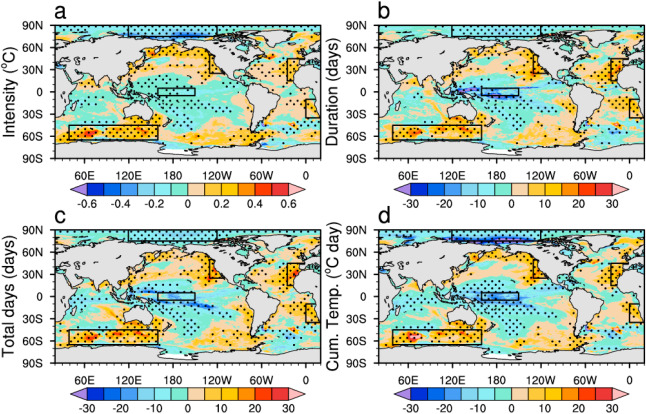全球增暖背景下,海洋热浪的发生频率和持续时间都发生了显著的增长。海洋生态系统对于海洋热浪的侵袭表现出很高的脆弱性,引发了极为严重的生态和社会经济影响。不同模式情景对于特定增温背景(如1.5/2度)下的气候响应评估存在较大的差异。
近日,博士研究生刘佳伟在徐海明教授和罗京佳教授的联合指导下与其他合作者共同研究了海洋热浪在全球1.5度增温背景下平衡态和瞬变态响应的差异,相关成果发表于《Weather and Climate Extremes》。研究表明,尽管平衡态和瞬变态模拟中全球平均的海洋热浪特征指数变化十分相似,但是在许多气候热点区域却存在着非常显著的区域性差异(Fig. 1)。东边间上升流和南印度洋地区在平衡态下将遭受更强的海洋热浪,主要是由于局地海气相互作用和次表层海温增暖带来了更强的海表平均温度。而由于增温趋势和海冰的影响,平衡态下赤道中太平洋和北冰洋的海洋热浪反而会有所缓解。两种情景下显著的区域差异表明我们需要重新审视已有的基于瞬变态模拟的气候评估。

Fig. 1. Multi-ensemble mean differences between stabilized and transient 1.5 °C warming in MHW characteristics. Differences (stabilization minus transient responses) in intensity (a), duration (b), total days (c) and cumulative temperature (d). The tropical Pacific (160°E−150°W; 5°S-5°N), the Northeast Pacific (150°W-130°W; 25°N-55°N), the Northeast Atlantic (25°W-5°E; 15°N-45°N), the Southeast Atlantic (0°-20°E; 35°S-10°S), the Arctic (120°E−120°W; 75°N-90°N) and the southern Indian Ocean (40°E−160°E; 65°S-45°S) are outlined byrectangles. Stippling denotes significance above the 95% confidence level, determined by the two-tailed Student t-test.
论文信息:
Liu, J., Luo, J. J., Xu, H., Ma, J., Deng, J., Zhang, L., et al. (2021). Robust regional differences in marine heatwaves between transient and stabilization responses at 1.5° C global warming. Weather and Climate Extremes, 32, 100316. https://doi.org/10.1016/j.wace.2021.100316